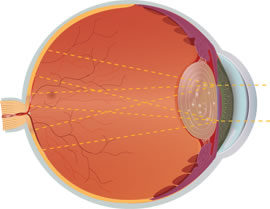

Cataracts
The Outside Clinic leaflets are designed to provide you, your friends and family with relevant information so that you will have a better understanding of your eye condition, how it will affect you, the treatments available and continued care.
What is a cataract?
A cataract is a condition that affects the lens, which is the clear tissue found behind the coloured part of the eye (iris), whose function is to focus light on to the back of the eye in order to provide a clear image. As we age it is normal for the lens to become less clear, reducing the amount of light passing through it, making it harder to see and causing vision to become dull and blurry. Eventually, the lens may become very cloudy and even opaque - this is known as a cataract. Cataracts most commonly occur in older people and may be part of the ageing process. However, younger people may also develop cataracts as a result of other conditions such as diabetes. The exact cause of cataracts is uncertain, but some causes may be excessive exposure to sunlight, smoking and poor diet.
How can this be treated?
The treatment for a cataract is surgery. The most common form of surgery is a technique known as phacoemulsification (this is not laser as sometimes thought). A very small incision is made in the transparent part of the eye (the cornea), which allows for a small flap to be opened. An ultrasound probe is then used to break up the lens containing the cataract, which is then removed by suction. A new, artificial replacement lens is then inserted into the space left and the flap is allowed to close again. Stitches are not usually required.
What are the benefits of cataract surgery?
The main benefits of having your cataract removed are improved clarity of vision and colour vision.
What happens if I decide to have it removed?
You will receive an appointment for a pre-operative assessment at the hospital, which will normally take 2-3 hours. During this visit you will be given information about the operation day and the aftercare you can expect. Various measurements will be taken to determine the strength of the artificial replacement lens.
What happens on the day of surgery?
Before leaving home remember to put in the eye drops
given to you at pre-operative assessment. When you
arrive the nurse will administer more dilating drops and
the doctor will mark the eye for surgery. The eye will be
anaesthetised and you will be taken through to the
theatre. The operation and anaesthetic take about 45 minutes.
What should I expect after surgery?
After surgery, you will arrive back at the eye unit from theatre with a plastic shield and patch over your eye and you will be offered refreshments. Your eye pad will be removed and your vision checked. The plastic shield will be replaced. You will then be given a pack containing drops, information sheets, an appointment card and one tablet (Diamox) which reduces pressure in the eye. Then, as long as you feel all right, you are able to go home. You may experience some mild discomfort in the eye, although this can normally be relieved with paracetamol. Due to the use of drops to dilate your eye, it is normal for your vision to remain blurred for up to 24 hours afterwards and your sight should continue to gradually improve over a few days but may take some weeks to heal fully. After your drops are completed you will normally be able to visit your optician for new spectacles.
Do I need to go to the hospital clinic again?
Yes, you will need to be seen again about a week or 10 days after your operation and you will normally be given the date of your follow up appointment before you leave the eye unit after your operation.
I have another eye condition; will this affect the outcome of my surgery?
If you have another eye condition such as glaucoma, diabetes or age related macular degeneration, the quality of your vision may still be limited, even after successful surgery. Your doctor will discuss your prognosis with you prior to surgery and will give you all of the information that you will need in order to make an informed decision.
Will I need spectacles after surgery?
You will be advised to have your eyes tested again approximately 4 to 6 weeks after surgery to assess the health of the eyes and your new spectacle prescription. Although accurate measurements are taken to ensure that any spectacle correction required following surgery is kept to a minimum, it is very likely that spectacles may still need to be worn, especially for near vision tasks.
Eye Health
- Why Sight Tests Are Important
- Glaucoma
- Cataracts
- Macular Degeneration
- Diabetic Retinopathy
- Low Vision Aids
- Spectacles
- Suitable Frames
- Smoking
- Nutrition
(coming soon)

